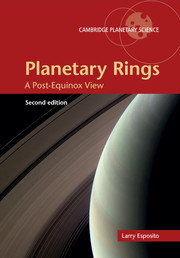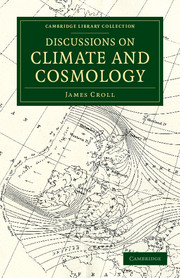Refine listing
Actions for selected content:
17000 results
4 - Individual ring particles and their collisions
-
- Book:
- Planetary Rings
- Published online:
- 05 March 2014
- Print publication:
- 06 March 2014, pp 35-53
-
- Chapter
- Export citation
Planetary Rings - Title page
-
-
- Book:
- Planetary Rings
- Published online:
- 05 March 2014
- Print publication:
- 06 March 2014, pp v-v
-
- Chapter
- Export citation
17 - Concluding remarks
-
- Book:
- Planetary Rings
- Published online:
- 05 March 2014
- Print publication:
- 06 March 2014, pp 203-207
-
- Chapter
- Export citation
1 - Introduction
-
- Book:
- Planetary Rings
- Published online:
- 05 March 2014
- Print publication:
- 06 March 2014, pp 1-5
-
- Chapter
- Export citation

Astronomicon
-
- Published online:
- 05 March 2014
- Print publication:
- 19 May 2011
- First published in:
- 1912

Planetary Rings
- A Post-Equinox View
-
- Published online:
- 05 March 2014
- Print publication:
- 06 March 2014

A Popular Guide to the Heavens
-
- Published online:
- 05 March 2014
- Print publication:
- 19 September 2013

The Life of Roger Langdon
- Told by Himself, with Additions by his Daughter
-
- Published online:
- 05 March 2014
- Print publication:
- 18 November 2010
- First published in:
- 1909

Discussions on Climate and Cosmology
-
- Published online:
- 05 March 2014
- Print publication:
- 21 February 2013
- First published in:
- 1885

A Treatise on Spherical Astronomy
-
- Published online:
- 05 March 2014
- Print publication:
- 22 August 2013
- First published in:
- 1908
5 - The composition of Titan's atmosphere
-
-
- Book:
- Titan
- Published online:
- 05 January 2014
- Print publication:
- 24 February 2014, pp 158-189
-
- Chapter
- Export citation
8 - Titan's haze
-
-
- Book:
- Titan
- Published online:
- 05 January 2014
- Print publication:
- 24 February 2014, pp 285-321
-
- Chapter
- Export citation
11 - Titan's ionosphere
-
-
- Book:
- Titan
- Published online:
- 05 January 2014
- Print publication:
- 24 February 2014, pp 376-418
-
- Chapter
- Export citation
6 - Storms, clouds, and weather
-
-
- Book:
- Titan
- Published online:
- 05 January 2014
- Print publication:
- 24 February 2014, pp 190-223
-
- Chapter
- Export citation
Contents
-
- Book:
- Titan
- Published online:
- 05 January 2014
- Print publication:
- 24 February 2014, pp vii-viii
-
- Chapter
- Export citation
1 - The origin and evolution of Titan
-
-
- Book:
- Titan
- Published online:
- 05 January 2014
- Print publication:
- 24 February 2014, pp 29-62
-
- Chapter
- Export citation
Contributors
-
- Book:
- Titan
- Published online:
- 05 January 2014
- Print publication:
- 24 February 2014, pp ix-xii
-
- Chapter
- Export citation
9 - Titan's upper atmosphere: thermal structure, dynamics, and energetics
-
-
- Book:
- Titan
- Published online:
- 05 January 2014
- Print publication:
- 24 February 2014, pp 322-354
-
- Chapter
- Export citation
2 - Titan's surface geology
-
-
- Book:
- Titan
- Published online:
- 05 January 2014
- Print publication:
- 24 February 2014, pp 63-101
-
- Chapter
- Export citation
12 - Titan's magnetospheric and plasma environment
-
-
- Book:
- Titan
- Published online:
- 05 January 2014
- Print publication:
- 24 February 2014, pp 419-458
-
- Chapter
- Export citation
